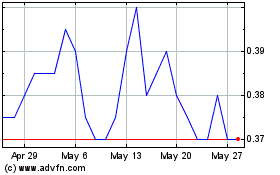Positive Pre-Clinical Results Using CelGro® in Anterior Cruciate Ligament (ACL) Reconstruction
05 February 2018 - 3:28PM
Business Wire
- Orthocell successfully conducted a
pre-clinical evaluation using CelGro® collagen rope to replace the
need for an autologous tendon graft for ACL reconstruction
- Study showed host ligament stem cells
from ACL stump are capable of ingrowth into the biomechanically
superior CelGro® rope, representing a key breakthrough in the use
of collagen scaffolds
- CelGro® collagen rope has the potential
to greatly improve ACL reconstruction outcomes and is capable of
replacing legacy autologous graft for ACL reconstruction
- Orthocell plans to rapidly advance
development of this technology
Regenerative medicine company Orthocell Limited (ASX:OCC)
(“Orthocell” or the “Company”) is pleased to announce positive
pre-clinical results using CelGro® collagen rope for Anterior
Cruciate Ligament (ACL) reconstruction.
This press release features multimedia. View
the full release here:
http://www.businesswire.com/news/home/20180204005104/en/
Figure 1 - An illustration depicting a
ruptured ACL (Graphic: Business Wire)
Orthocell Managing Director Paul Anderson said: “We are
extremely excited by the potential of this technology. An off the
shelf biological device that augments ACL reconstruction is highly
desired by the orthopaedic industry and Orthocell is ideally placed
to deliver a superior product in this rapidly growing and lucrative
market. Not only does this data support the potential for an off
the shelf augment to ACL reconstruction, but it also acts to
validate CelGro® as a collagen medical device platform technology,
for use across multiple indications including bone, tendons and
peripheral nerves.”
The pre-clinical study was led by Chief Scientific Officer,
Professor Ming-Hao Zheng, in conjunction with the University of
Western Australia. The study was designed to show CelGro® collagen
rope was equal to, or better than the use of an autologous tendon
graft (such as hamstring) for ACL reconstruction, which can result
in donor site discomfort and other associated complications.
The top line data indicated CelGro® rope, made from braided
collagen fibers has superior biomechanical properties and is
capable of replacing autologous grafts for ACL reconstruction.
Further, the host ligament stem cells from the ACL stump are
capable of ingrowth into the collagen rope for tissue regeneration
and integrating with native bone with a tensile strength similar to
that of the natural ligament. Professor Zheng presented the
positive results at the Raine Medical Research Foundation ACL
symposium (“ACL Symposium”), highlighting that collagen rope may
eliminate the need for autograft harvest, thus circumventing the
donor site morbidity.
Professor Freddie Fu, keynote speaker at the ACL Symposium,
Chairman of the Department of Orthopaedic Surgery, University of
Pittsburgh School of Medicine, specialist in ACL reconstruction,
commented: “The use of this new collagen rope for ACL
reconstruction is very promising. It could reduce the donor site
morbidity and shorten surgical timeframes.” Professor Freddie Fu is
a world-renowned orthopaedic surgeon and has treated high profile
athletes, including Zlatan Ibrahimovic, striker for Manchester
United.
72 cases were involved in the study with 36 cases receiving an
autograft and the other 36 cases receiving CelGro® collagen rope
for ACL reconstruction. Cases were evaluated at multiple time
points undergoing either a regeneration assessment or mechanical
test to assess the performance of the CelGro® collagen rope when
compared to autologous tendon graft for ACL reconstruction. More
pre-clinical studies will be required before human trials can
begin.
Treatment of ruptured anterior cruciate ligaments
The ACL is one of the major stabilising ligaments of the knee.
It connects the thigh bone (femur) to the shin bone (tibia), and
once it ruptures, it is incapable of healing. The ACL can be
injured in several ways including changing direction rapidly,
landing from a jump or direct contact or impact. A ruptured ACL is
a common injury suffered by active patients, usually requiring
surgical intervention, with a long period for rehabilitation before
returning to preinjury activities. There are between 100,000 and
200,000 ACL ruptures per year in the United States alone.
Successful ACL reconstruction surgery tightens your knee and
restores its stability. It also helps patients avoid further injury
and a return to work and playing sports. Surgical repair mostly
involves reconstructing the ACL using grafts from the patient’s
hamstring tendon, a procedure that removes part of the patients own
tendon to take the place of the ruptured ACL. However, harvesting
the patient’s tendon to replace the ruptured ACL is time consuming
and can be problematic with ongoing donor site discomfort and in
some cases subsequent rupturing of the harvested tendon.
To address the ACL reconstruction issues, Orthocell is
developing a biological augment for ACL reconstruction, which could
make treatment much more efficient and effective by simplifying
techniques, reducing surgery time and mitigating the risks
associated with harvesting the patient’s own tendon.
See Figure 1: An illustration depicting a ruptured ACL
See Figure 2: Example of ACL reconstruction using CelGro®
collagen rope
View source
version on businesswire.com: http://www.businesswire.com/news/home/20180204005104/en/
General enquiries:Orthocell LimitedPaul Anderson, +61 8 9360
2888Managing Directorpaulanderson@orthocell.com.auorInvestor
enquiries:Vesparum CapitalJoel Seah, +61 3 8582
4800orthocell@vesparum.comorMedia enquiriesWE BuchanBen Walsh, +61
411 520 012bwalsh@buchanwe.com.au
Orthocell (ASX:OCC)
Historical Stock Chart
From Nov 2024 to Dec 2024

Orthocell (ASX:OCC)
Historical Stock Chart
From Dec 2023 to Dec 2024
